Information Systems and Big Data: Techniques and Business Impact
VerifiedAdded on 2023/06/17
|7
|2082
|358
Report
AI Summary
This report provides an overview of big data analysis, focusing on its characteristics, challenges, and techniques. It discusses the different types of big data (structured, semi-structured, and unstructured) and highlights key characteristics such as volume, variety, value, volatility, velocity, visualization, and veracity. The report also addresses the challenges associated with big data analytics, including data security, integration from diverse sources, and the lack of proper understanding of complex data. Various techniques for big data analysis, such as A/B testing, statistics, and machine learning, are explored, along with how big data technology supports business growth through improved efficiencies, automated decision-making, and the identification of new opportunities. The report concludes by emphasizing the importance of big data analysis for businesses to sustain competitiveness in the market.
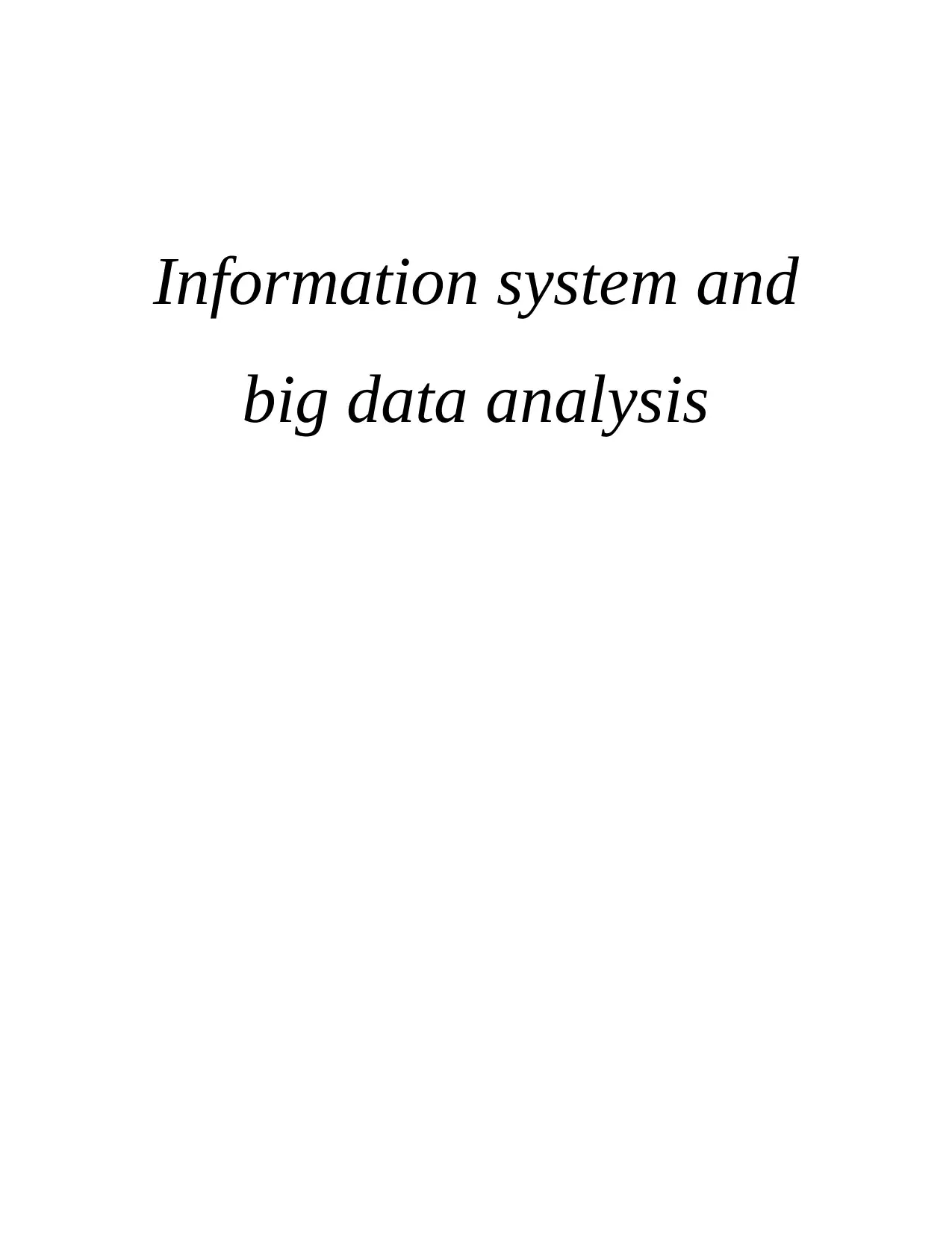
Information system and
big data analysis
big data analysis
Paraphrase This Document
Need a fresh take? Get an instant paraphrase of this document with our AI Paraphraser
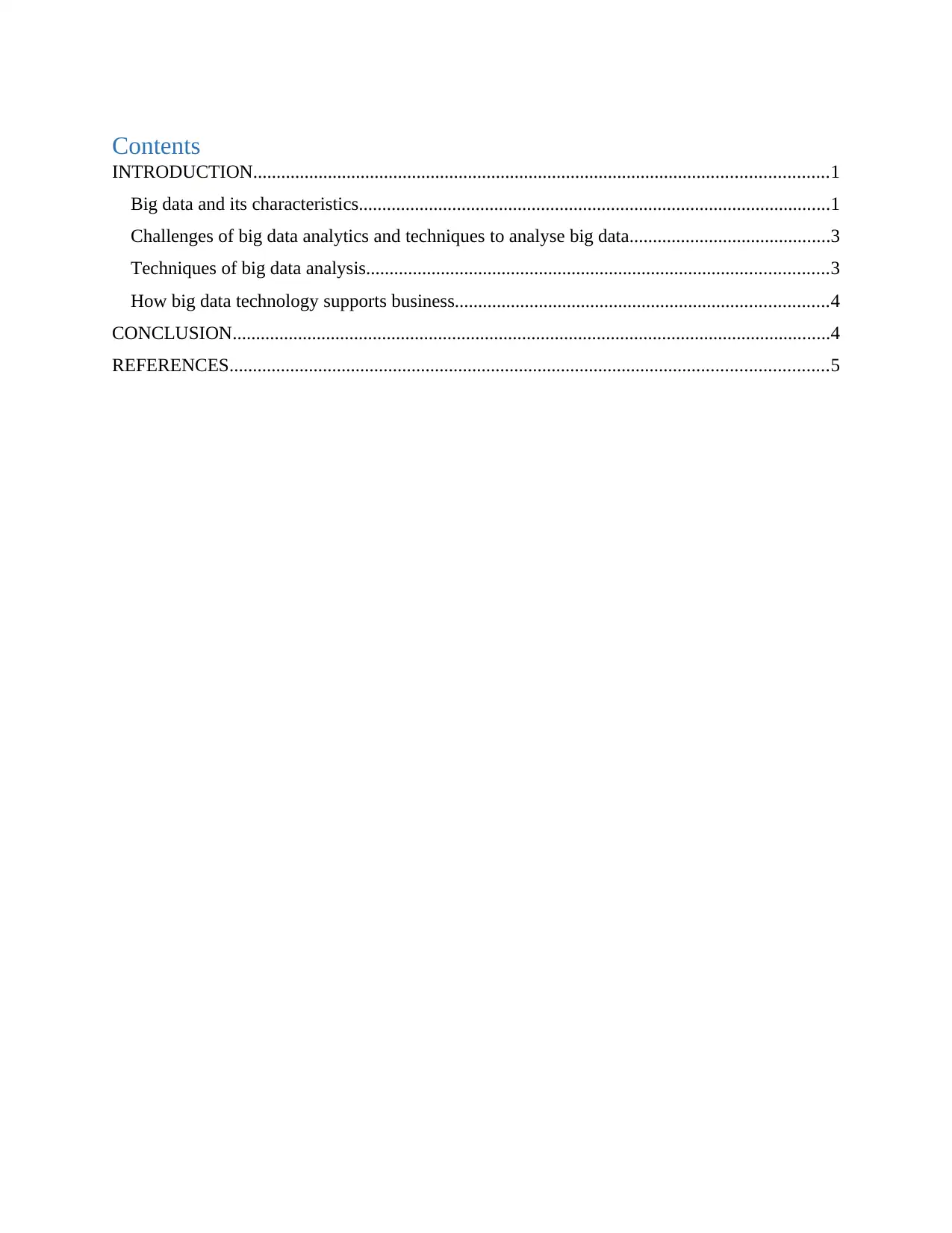
Contents
INTRODUCTION...........................................................................................................................1
Big data and its characteristics.....................................................................................................1
Challenges of big data analytics and techniques to analyse big data...........................................3
Techniques of big data analysis...................................................................................................3
How big data technology supports business................................................................................4
CONCLUSION................................................................................................................................4
REFERENCES................................................................................................................................5
INTRODUCTION...........................................................................................................................1
Big data and its characteristics.....................................................................................................1
Challenges of big data analytics and techniques to analyse big data...........................................3
Techniques of big data analysis...................................................................................................3
How big data technology supports business................................................................................4
CONCLUSION................................................................................................................................4
REFERENCES................................................................................................................................5
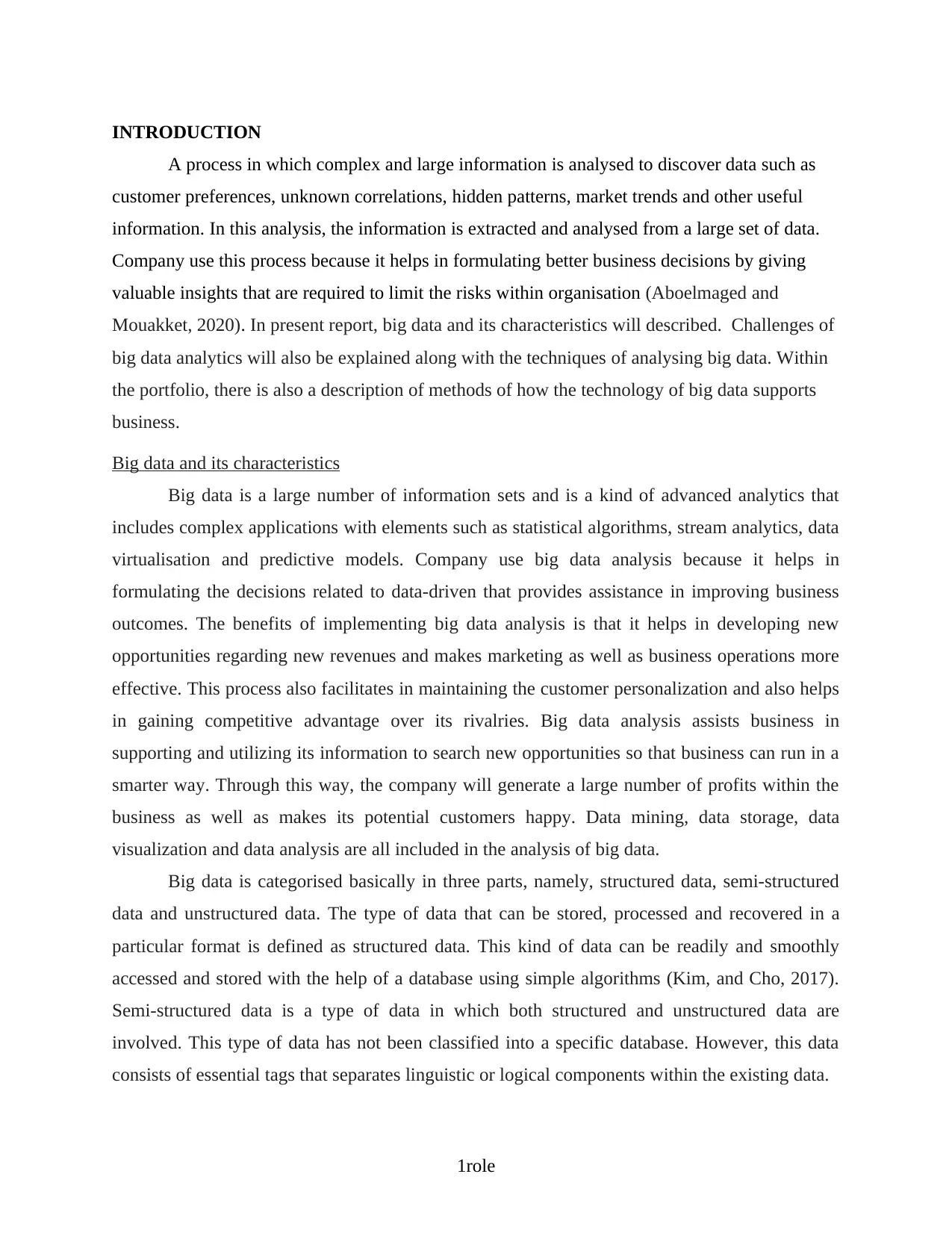
INTRODUCTION
A process in which complex and large information is analysed to discover data such as
customer preferences, unknown correlations, hidden patterns, market trends and other useful
information. In this analysis, the information is extracted and analysed from a large set of data.
Company use this process because it helps in formulating better business decisions by giving
valuable insights that are required to limit the risks within organisation (Aboelmaged and
Mouakket, 2020). In present report, big data and its characteristics will described. Challenges of
big data analytics will also be explained along with the techniques of analysing big data. Within
the portfolio, there is also a description of methods of how the technology of big data supports
business.
Big data and its characteristics
Big data is a large number of information sets and is a kind of advanced analytics that
includes complex applications with elements such as statistical algorithms, stream analytics, data
virtualisation and predictive models. Company use big data analysis because it helps in
formulating the decisions related to data-driven that provides assistance in improving business
outcomes. The benefits of implementing big data analysis is that it helps in developing new
opportunities regarding new revenues and makes marketing as well as business operations more
effective. This process also facilitates in maintaining the customer personalization and also helps
in gaining competitive advantage over its rivalries. Big data analysis assists business in
supporting and utilizing its information to search new opportunities so that business can run in a
smarter way. Through this way, the company will generate a large number of profits within the
business as well as makes its potential customers happy. Data mining, data storage, data
visualization and data analysis are all included in the analysis of big data.
Big data is categorised basically in three parts, namely, structured data, semi-structured
data and unstructured data. The type of data that can be stored, processed and recovered in a
particular format is defined as structured data. This kind of data can be readily and smoothly
accessed and stored with the help of a database using simple algorithms (Kim, and Cho, 2017).
Semi-structured data is a type of data in which both structured and unstructured data are
involved. This type of data has not been classified into a specific database. However, this data
consists of essential tags that separates linguistic or logical components within the existing data.
1role
A process in which complex and large information is analysed to discover data such as
customer preferences, unknown correlations, hidden patterns, market trends and other useful
information. In this analysis, the information is extracted and analysed from a large set of data.
Company use this process because it helps in formulating better business decisions by giving
valuable insights that are required to limit the risks within organisation (Aboelmaged and
Mouakket, 2020). In present report, big data and its characteristics will described. Challenges of
big data analytics will also be explained along with the techniques of analysing big data. Within
the portfolio, there is also a description of methods of how the technology of big data supports
business.
Big data and its characteristics
Big data is a large number of information sets and is a kind of advanced analytics that
includes complex applications with elements such as statistical algorithms, stream analytics, data
virtualisation and predictive models. Company use big data analysis because it helps in
formulating the decisions related to data-driven that provides assistance in improving business
outcomes. The benefits of implementing big data analysis is that it helps in developing new
opportunities regarding new revenues and makes marketing as well as business operations more
effective. This process also facilitates in maintaining the customer personalization and also helps
in gaining competitive advantage over its rivalries. Big data analysis assists business in
supporting and utilizing its information to search new opportunities so that business can run in a
smarter way. Through this way, the company will generate a large number of profits within the
business as well as makes its potential customers happy. Data mining, data storage, data
visualization and data analysis are all included in the analysis of big data.
Big data is categorised basically in three parts, namely, structured data, semi-structured
data and unstructured data. The type of data that can be stored, processed and recovered in a
particular format is defined as structured data. This kind of data can be readily and smoothly
accessed and stored with the help of a database using simple algorithms (Kim, and Cho, 2017).
Semi-structured data is a type of data in which both structured and unstructured data are
involved. This type of data has not been classified into a specific database. However, this data
consists of essential tags that separates linguistic or logical components within the existing data.
1role
⊘ This is a preview!⊘
Do you want full access?
Subscribe today to unlock all pages.

Trusted by 1+ million students worldwide
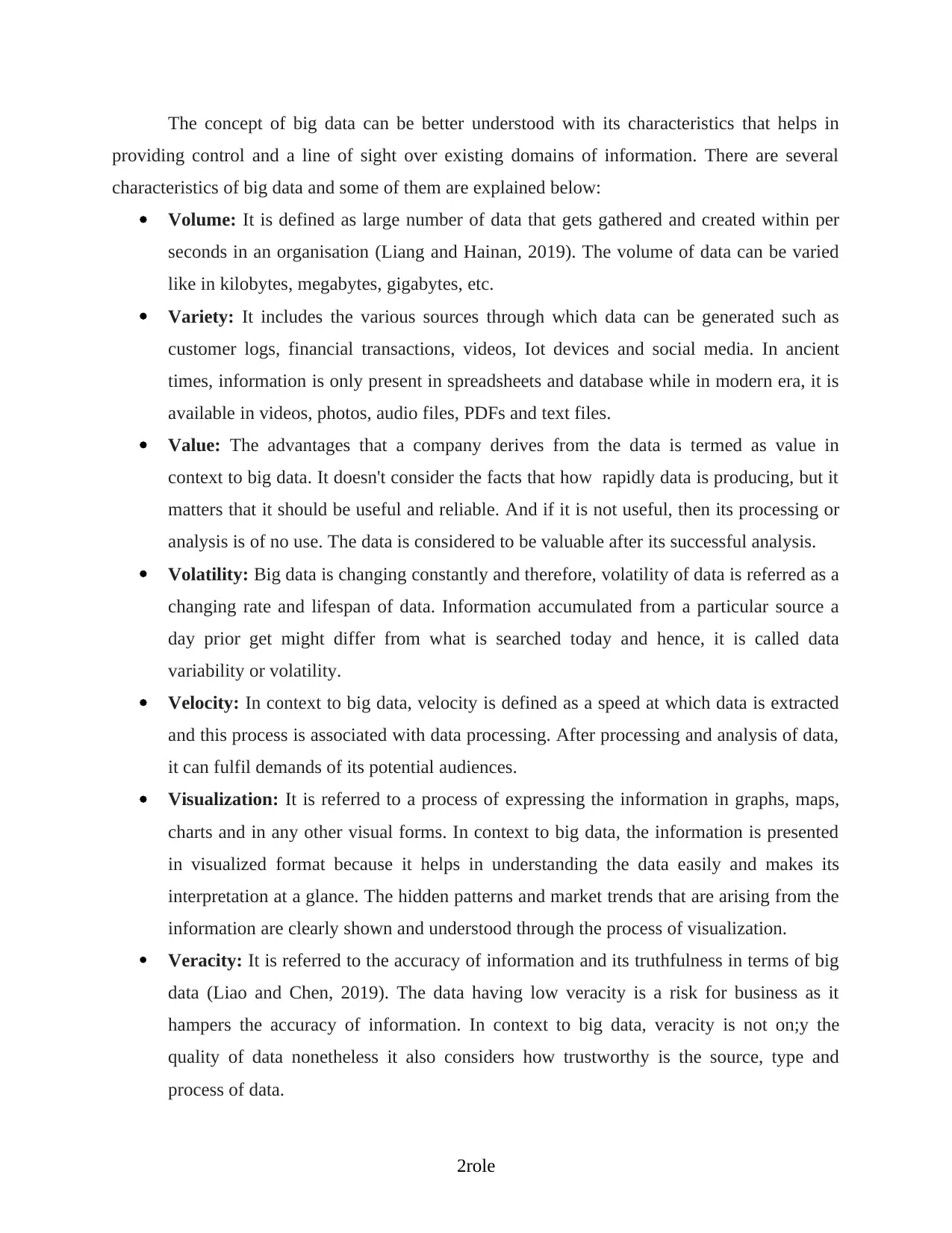
The concept of big data can be better understood with its characteristics that helps in
providing control and a line of sight over existing domains of information. There are several
characteristics of big data and some of them are explained below:
Volume: It is defined as large number of data that gets gathered and created within per
seconds in an organisation (Liang and Hainan, 2019). The volume of data can be varied
like in kilobytes, megabytes, gigabytes, etc.
Variety: It includes the various sources through which data can be generated such as
customer logs, financial transactions, videos, Iot devices and social media. In ancient
times, information is only present in spreadsheets and database while in modern era, it is
available in videos, photos, audio files, PDFs and text files.
Value: The advantages that a company derives from the data is termed as value in
context to big data. It doesn't consider the facts that how rapidly data is producing, but it
matters that it should be useful and reliable. And if it is not useful, then its processing or
analysis is of no use. The data is considered to be valuable after its successful analysis.
Volatility: Big data is changing constantly and therefore, volatility of data is referred as a
changing rate and lifespan of data. Information accumulated from a particular source a
day prior get might differ from what is searched today and hence, it is called data
variability or volatility.
Velocity: In context to big data, velocity is defined as a speed at which data is extracted
and this process is associated with data processing. After processing and analysis of data,
it can fulfil demands of its potential audiences.
Visualization: It is referred to a process of expressing the information in graphs, maps,
charts and in any other visual forms. In context to big data, the information is presented
in visualized format because it helps in understanding the data easily and makes its
interpretation at a glance. The hidden patterns and market trends that are arising from the
information are clearly shown and understood through the process of visualization.
Veracity: It is referred to the accuracy of information and its truthfulness in terms of big
data (Liao and Chen, 2019). The data having low veracity is a risk for business as it
hampers the accuracy of information. In context to big data, veracity is not on;y the
quality of data nonetheless it also considers how trustworthy is the source, type and
process of data.
2role
providing control and a line of sight over existing domains of information. There are several
characteristics of big data and some of them are explained below:
Volume: It is defined as large number of data that gets gathered and created within per
seconds in an organisation (Liang and Hainan, 2019). The volume of data can be varied
like in kilobytes, megabytes, gigabytes, etc.
Variety: It includes the various sources through which data can be generated such as
customer logs, financial transactions, videos, Iot devices and social media. In ancient
times, information is only present in spreadsheets and database while in modern era, it is
available in videos, photos, audio files, PDFs and text files.
Value: The advantages that a company derives from the data is termed as value in
context to big data. It doesn't consider the facts that how rapidly data is producing, but it
matters that it should be useful and reliable. And if it is not useful, then its processing or
analysis is of no use. The data is considered to be valuable after its successful analysis.
Volatility: Big data is changing constantly and therefore, volatility of data is referred as a
changing rate and lifespan of data. Information accumulated from a particular source a
day prior get might differ from what is searched today and hence, it is called data
variability or volatility.
Velocity: In context to big data, velocity is defined as a speed at which data is extracted
and this process is associated with data processing. After processing and analysis of data,
it can fulfil demands of its potential audiences.
Visualization: It is referred to a process of expressing the information in graphs, maps,
charts and in any other visual forms. In context to big data, the information is presented
in visualized format because it helps in understanding the data easily and makes its
interpretation at a glance. The hidden patterns and market trends that are arising from the
information are clearly shown and understood through the process of visualization.
Veracity: It is referred to the accuracy of information and its truthfulness in terms of big
data (Liao and Chen, 2019). The data having low veracity is a risk for business as it
hampers the accuracy of information. In context to big data, veracity is not on;y the
quality of data nonetheless it also considers how trustworthy is the source, type and
process of data.
2role
Paraphrase This Document
Need a fresh take? Get an instant paraphrase of this document with our AI Paraphraser
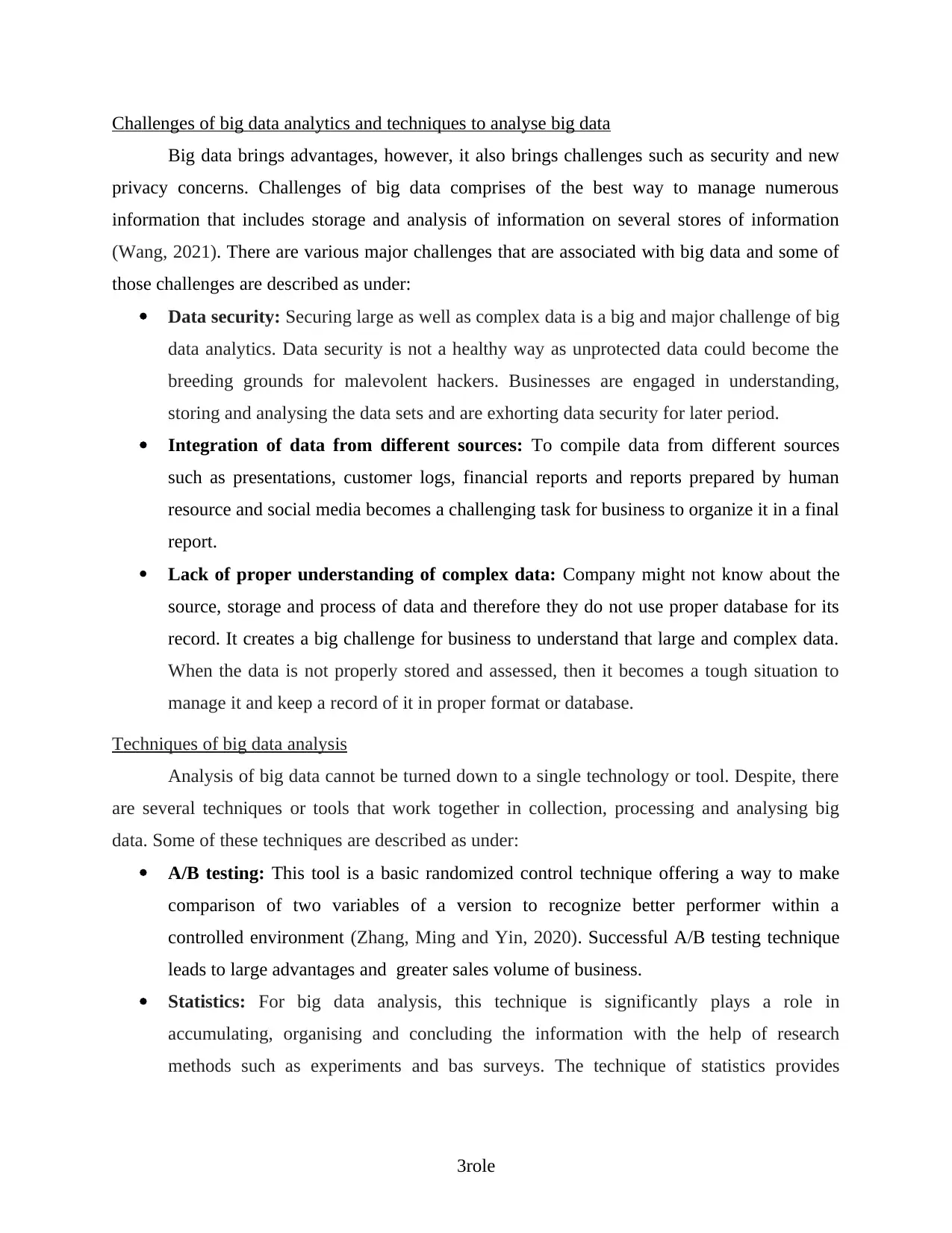
Challenges of big data analytics and techniques to analyse big data
Big data brings advantages, however, it also brings challenges such as security and new
privacy concerns. Challenges of big data comprises of the best way to manage numerous
information that includes storage and analysis of information on several stores of information
(Wang, 2021). There are various major challenges that are associated with big data and some of
those challenges are described as under:
Data security: Securing large as well as complex data is a big and major challenge of big
data analytics. Data security is not a healthy way as unprotected data could become the
breeding grounds for malevolent hackers. Businesses are engaged in understanding,
storing and analysing the data sets and are exhorting data security for later period.
Integration of data from different sources: To compile data from different sources
such as presentations, customer logs, financial reports and reports prepared by human
resource and social media becomes a challenging task for business to organize it in a final
report.
Lack of proper understanding of complex data: Company might not know about the
source, storage and process of data and therefore they do not use proper database for its
record. It creates a big challenge for business to understand that large and complex data.
When the data is not properly stored and assessed, then it becomes a tough situation to
manage it and keep a record of it in proper format or database.
Techniques of big data analysis
Analysis of big data cannot be turned down to a single technology or tool. Despite, there
are several techniques or tools that work together in collection, processing and analysing big
data. Some of these techniques are described as under:
A/B testing: This tool is a basic randomized control technique offering a way to make
comparison of two variables of a version to recognize better performer within a
controlled environment (Zhang, Ming and Yin, 2020). Successful A/B testing technique
leads to large advantages and greater sales volume of business.
Statistics: For big data analysis, this technique is significantly plays a role in
accumulating, organising and concluding the information with the help of research
methods such as experiments and bas surveys. The technique of statistics provides
3role
Big data brings advantages, however, it also brings challenges such as security and new
privacy concerns. Challenges of big data comprises of the best way to manage numerous
information that includes storage and analysis of information on several stores of information
(Wang, 2021). There are various major challenges that are associated with big data and some of
those challenges are described as under:
Data security: Securing large as well as complex data is a big and major challenge of big
data analytics. Data security is not a healthy way as unprotected data could become the
breeding grounds for malevolent hackers. Businesses are engaged in understanding,
storing and analysing the data sets and are exhorting data security for later period.
Integration of data from different sources: To compile data from different sources
such as presentations, customer logs, financial reports and reports prepared by human
resource and social media becomes a challenging task for business to organize it in a final
report.
Lack of proper understanding of complex data: Company might not know about the
source, storage and process of data and therefore they do not use proper database for its
record. It creates a big challenge for business to understand that large and complex data.
When the data is not properly stored and assessed, then it becomes a tough situation to
manage it and keep a record of it in proper format or database.
Techniques of big data analysis
Analysis of big data cannot be turned down to a single technology or tool. Despite, there
are several techniques or tools that work together in collection, processing and analysing big
data. Some of these techniques are described as under:
A/B testing: This tool is a basic randomized control technique offering a way to make
comparison of two variables of a version to recognize better performer within a
controlled environment (Zhang, Ming and Yin, 2020). Successful A/B testing technique
leads to large advantages and greater sales volume of business.
Statistics: For big data analysis, this technique is significantly plays a role in
accumulating, organising and concluding the information with the help of research
methods such as experiments and bas surveys. The technique of statistics provides
3role
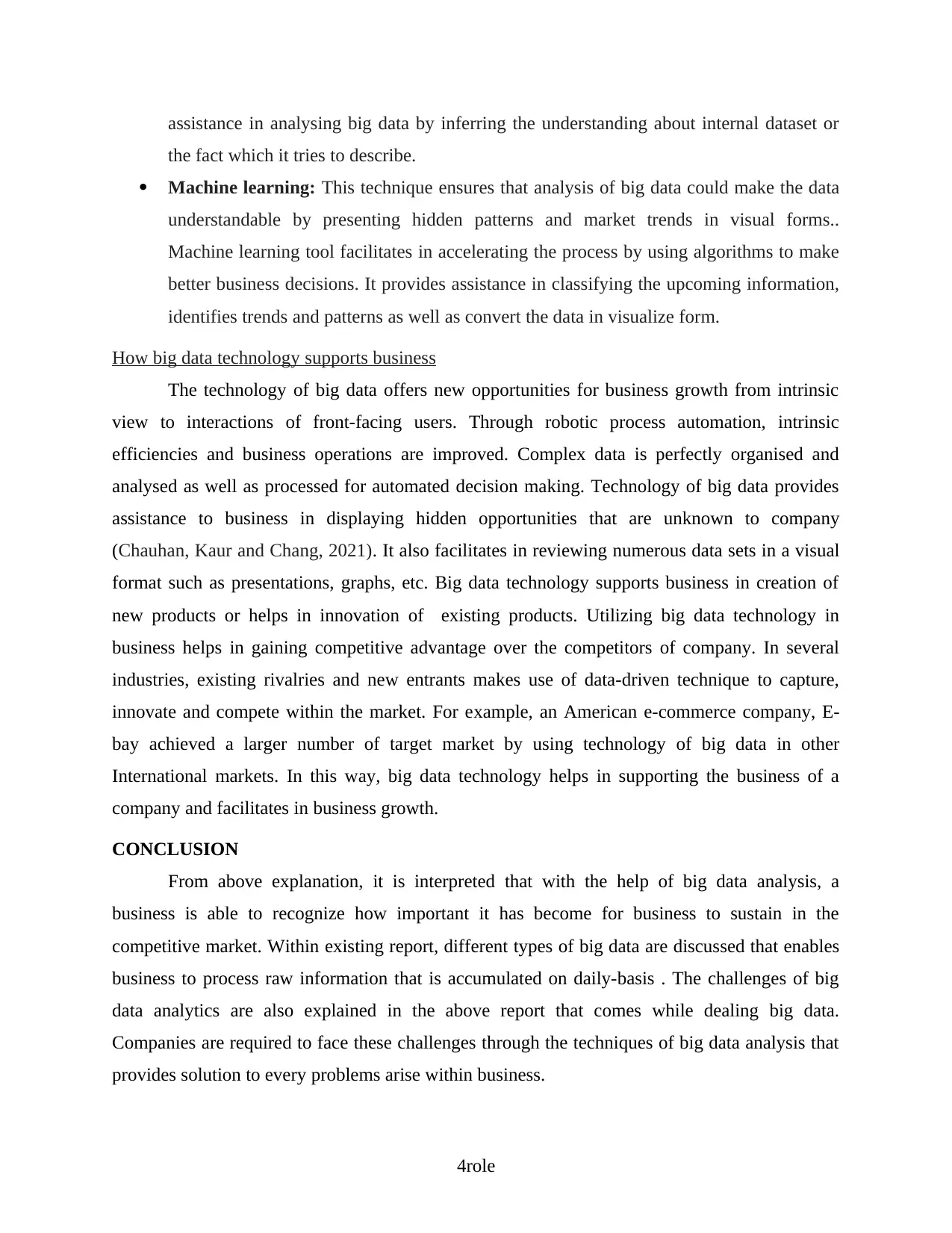
assistance in analysing big data by inferring the understanding about internal dataset or
the fact which it tries to describe.
Machine learning: This technique ensures that analysis of big data could make the data
understandable by presenting hidden patterns and market trends in visual forms..
Machine learning tool facilitates in accelerating the process by using algorithms to make
better business decisions. It provides assistance in classifying the upcoming information,
identifies trends and patterns as well as convert the data in visualize form.
How big data technology supports business
The technology of big data offers new opportunities for business growth from intrinsic
view to interactions of front-facing users. Through robotic process automation, intrinsic
efficiencies and business operations are improved. Complex data is perfectly organised and
analysed as well as processed for automated decision making. Technology of big data provides
assistance to business in displaying hidden opportunities that are unknown to company
(Chauhan, Kaur and Chang, 2021). It also facilitates in reviewing numerous data sets in a visual
format such as presentations, graphs, etc. Big data technology supports business in creation of
new products or helps in innovation of existing products. Utilizing big data technology in
business helps in gaining competitive advantage over the competitors of company. In several
industries, existing rivalries and new entrants makes use of data-driven technique to capture,
innovate and compete within the market. For example, an American e-commerce company, E-
bay achieved a larger number of target market by using technology of big data in other
International markets. In this way, big data technology helps in supporting the business of a
company and facilitates in business growth.
CONCLUSION
From above explanation, it is interpreted that with the help of big data analysis, a
business is able to recognize how important it has become for business to sustain in the
competitive market. Within existing report, different types of big data are discussed that enables
business to process raw information that is accumulated on daily-basis . The challenges of big
data analytics are also explained in the above report that comes while dealing big data.
Companies are required to face these challenges through the techniques of big data analysis that
provides solution to every problems arise within business.
4role
the fact which it tries to describe.
Machine learning: This technique ensures that analysis of big data could make the data
understandable by presenting hidden patterns and market trends in visual forms..
Machine learning tool facilitates in accelerating the process by using algorithms to make
better business decisions. It provides assistance in classifying the upcoming information,
identifies trends and patterns as well as convert the data in visualize form.
How big data technology supports business
The technology of big data offers new opportunities for business growth from intrinsic
view to interactions of front-facing users. Through robotic process automation, intrinsic
efficiencies and business operations are improved. Complex data is perfectly organised and
analysed as well as processed for automated decision making. Technology of big data provides
assistance to business in displaying hidden opportunities that are unknown to company
(Chauhan, Kaur and Chang, 2021). It also facilitates in reviewing numerous data sets in a visual
format such as presentations, graphs, etc. Big data technology supports business in creation of
new products or helps in innovation of existing products. Utilizing big data technology in
business helps in gaining competitive advantage over the competitors of company. In several
industries, existing rivalries and new entrants makes use of data-driven technique to capture,
innovate and compete within the market. For example, an American e-commerce company, E-
bay achieved a larger number of target market by using technology of big data in other
International markets. In this way, big data technology helps in supporting the business of a
company and facilitates in business growth.
CONCLUSION
From above explanation, it is interpreted that with the help of big data analysis, a
business is able to recognize how important it has become for business to sustain in the
competitive market. Within existing report, different types of big data are discussed that enables
business to process raw information that is accumulated on daily-basis . The challenges of big
data analytics are also explained in the above report that comes while dealing big data.
Companies are required to face these challenges through the techniques of big data analysis that
provides solution to every problems arise within business.
4role
⊘ This is a preview!⊘
Do you want full access?
Subscribe today to unlock all pages.

Trusted by 1+ million students worldwide
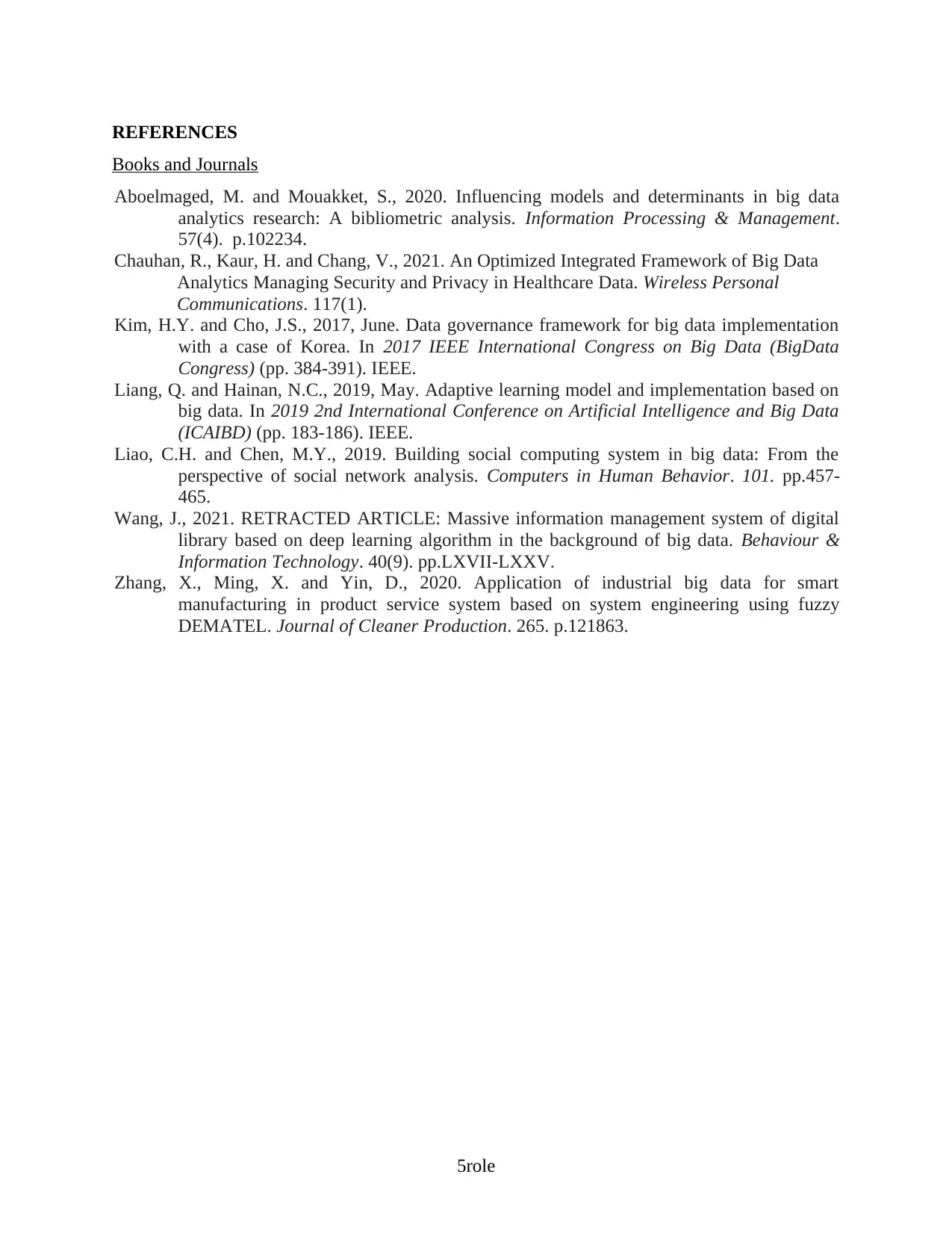
REFERENCES
Books and Journals
Aboelmaged, M. and Mouakket, S., 2020. Influencing models and determinants in big data
analytics research: A bibliometric analysis. Information Processing & Management.
57(4). p.102234.
Chauhan, R., Kaur, H. and Chang, V., 2021. An Optimized Integrated Framework of Big Data
Analytics Managing Security and Privacy in Healthcare Data. Wireless Personal
Communications. 117(1).
Kim, H.Y. and Cho, J.S., 2017, June. Data governance framework for big data implementation
with a case of Korea. In 2017 IEEE International Congress on Big Data (BigData
Congress) (pp. 384-391). IEEE.
Liang, Q. and Hainan, N.C., 2019, May. Adaptive learning model and implementation based on
big data. In 2019 2nd International Conference on Artificial Intelligence and Big Data
(ICAIBD) (pp. 183-186). IEEE.
Liao, C.H. and Chen, M.Y., 2019. Building social computing system in big data: From the
perspective of social network analysis. Computers in Human Behavior. 101. pp.457-
465.
Wang, J., 2021. RETRACTED ARTICLE: Massive information management system of digital
library based on deep learning algorithm in the background of big data. Behaviour &
Information Technology. 40(9). pp.LXVII-LXXV.
Zhang, X., Ming, X. and Yin, D., 2020. Application of industrial big data for smart
manufacturing in product service system based on system engineering using fuzzy
DEMATEL. Journal of Cleaner Production. 265. p.121863.
5role
Books and Journals
Aboelmaged, M. and Mouakket, S., 2020. Influencing models and determinants in big data
analytics research: A bibliometric analysis. Information Processing & Management.
57(4). p.102234.
Chauhan, R., Kaur, H. and Chang, V., 2021. An Optimized Integrated Framework of Big Data
Analytics Managing Security and Privacy in Healthcare Data. Wireless Personal
Communications. 117(1).
Kim, H.Y. and Cho, J.S., 2017, June. Data governance framework for big data implementation
with a case of Korea. In 2017 IEEE International Congress on Big Data (BigData
Congress) (pp. 384-391). IEEE.
Liang, Q. and Hainan, N.C., 2019, May. Adaptive learning model and implementation based on
big data. In 2019 2nd International Conference on Artificial Intelligence and Big Data
(ICAIBD) (pp. 183-186). IEEE.
Liao, C.H. and Chen, M.Y., 2019. Building social computing system in big data: From the
perspective of social network analysis. Computers in Human Behavior. 101. pp.457-
465.
Wang, J., 2021. RETRACTED ARTICLE: Massive information management system of digital
library based on deep learning algorithm in the background of big data. Behaviour &
Information Technology. 40(9). pp.LXVII-LXXV.
Zhang, X., Ming, X. and Yin, D., 2020. Application of industrial big data for smart
manufacturing in product service system based on system engineering using fuzzy
DEMATEL. Journal of Cleaner Production. 265. p.121863.
5role
1 out of 7
Related Documents
Your All-in-One AI-Powered Toolkit for Academic Success.
+13062052269
info@desklib.com
Available 24*7 on WhatsApp / Email
![[object Object]](/_next/static/media/star-bottom.7253800d.svg)
Unlock your academic potential
Copyright © 2020–2025 A2Z Services. All Rights Reserved. Developed and managed by ZUCOL.
